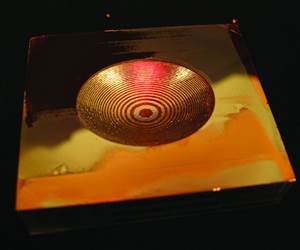6K Additive, Agile Space Industries Partner to Advance Moon Mission
6K Additive’s Nickel 625 powder is being qualified for use in Agile’s A2200 engine to leverage additive manufacturing for engine lightweighting while also delivering tremendous power.
6K Additive and Agile Space Industries are pursuing certification of 6K Additive-produced Ni625 powder for customer space applications including critical rocket parts. 6K Additive is a a division of 6K Inc. and a provider of sustainable materials for additive manufacturing (AM), while and Agile Space Industries is an in-space propulsion specialist.
6K Additive’s Ni625 powder is being certified for use at Agile’s manufacturing facility. The first parts to be produced will be used in Agile’s A2200 bipropellant hypergolic engine. The engine is powered by a pressure-fed hypergolic bipropellant, which does not require ignition as the hydrazine derivative fuel M20 and MON3 oxidizer combust on contact. Leveraging AM, the engine was designed to weigh just 5.9 kg and produce 500 lbs of thrust, underscoring the benefits of lightweighting with AM while delivering tremendous power.
“By weight, 85% of our engine components are additively manufactured, meaning we rely heavily on AM powders that can withstand the extreme temperatures and forces generated during takeoff and flight. 6K Additive allows us to additively manufacture using high-quality powders that are required for our critical applications, while also helping us meet our environmental goals through their recycling program and sustainably manufactured powders,” says Kyle Metsger, director of additive technology at Agile. “6K Additive can deliver extremely consistent powder that allows our production line to run the long build times required for these complex components.”
Traditional development cycles for aerospace components can be more than two decades. However, by harnessing the speed and flexibility of AM, Agile is able to compress development time down to 12 months. “A year-long development cycle still sounds like a very long time in many industries, but we are showing the primes in the aerospace industry what the future looks like,” Metsger adds. “Moving to the larger TruPrint 5000 machine gave us the ability to qualify the new parameters for the machine and material simultaneously. In this way, AM allows us to be ‘Agile’ in name and practice.”
Agile’s A2200 engines will be used on a Lunar lander vehicle. The A2200 engine was developed to provide maximum performance on demanding missions, with a specific impulse of more than 318 seconds. Using an integral pintle sleeve throttling mechanism, the engine is capable of deep throttling, providing a smooth ride and fine control for a variety of missions. The engine can throttle from 50 to 100% thrust in under 650 milliseconds, making it the perfect engine for heavily demanding maneuvering sequences that lunar missions require.
“We are always excited to partner with customers like Agile who leverage our high-quality powders to produce critical rocket parts to land on the moon,” says Frank Roberts, 6K Additive president. “The fact that we can enable space exploration while continuing to lead the way with sustainability at home on Earth is the best of both worlds. Agile has a cradle-to-grave mentality around its products, and having 6K Additive supply the company with high-quality, sustainably produced Ni625 and provide an established waste stream to help with its environmental stewardship speaks to our mission of going beyond expectations for our customers.”
- Learn about Morf3D and 6K Additive qualifying metal powders for aerospace customers. 6K Additive’s sustainably produced powders will be qualified for full industrialization and high-volume production.
- Read about 6K’s efforts to make the U.S. self-sufficient in aerospace alloy metal powders. 6K’s technology can upcycle titanium and nickel-alloy parts into additive manufacturing powder. Here is how the circular economy helps national security.
Related Content
Aluminum Gets Its Own Additive Manufacturing Process
Alloy Enterprises’ selective diffusion bonding process is specifically designed for high throughput production of aluminum parts, enabling additive manufacturing to compete with casting.
Read MorePostprocessing Steps and Costs for Metal 3D Printing
When your metal part is done 3D printing, you just pull it out of the machine and start using it, right? Not exactly.
Read MoreWhat is Powder Bed Fusion 3D Printing?
Whether in metal or polymer, with a laser or an electron beam, powder bed fusion (PBF) is one of the most widely used 3D printing techniques.
Read MoreAM 101: What is Ultrasonic Additive Manufacturing?
Going from additive to subtractive can be simple with Ultrasonic Additive Manufacturing (UAM). What is it and how does it work? Learn the basics in this 101 post.
Read MoreRead Next
4 Ways the Education and Training Challenge Is Different for Additive Manufacturing
The advance of additive manufacturing means we need more professionals educated in AM technology.
Read More3D Printing Brings Sustainability, Accessibility to Glass Manufacturing
Australian startup Maple Glass Printing has developed a process for extruding glass into artwork, lab implements and architectural elements. Along the way, the company has also found more efficient ways of recycling this material.
Read MoreAt General Atomics, Do Unmanned Aerial Systems Reveal the Future of Aircraft Manufacturing?
The maker of the Predator and SkyGuardian remote aircraft can implement additive manufacturing more rapidly and widely than the makers of other types of planes. The role of 3D printing in current and future UAS components hints at how far AM can go to save cost and time in aircraft production and design.
Read More








.png;maxWidth=300;quality=90)















